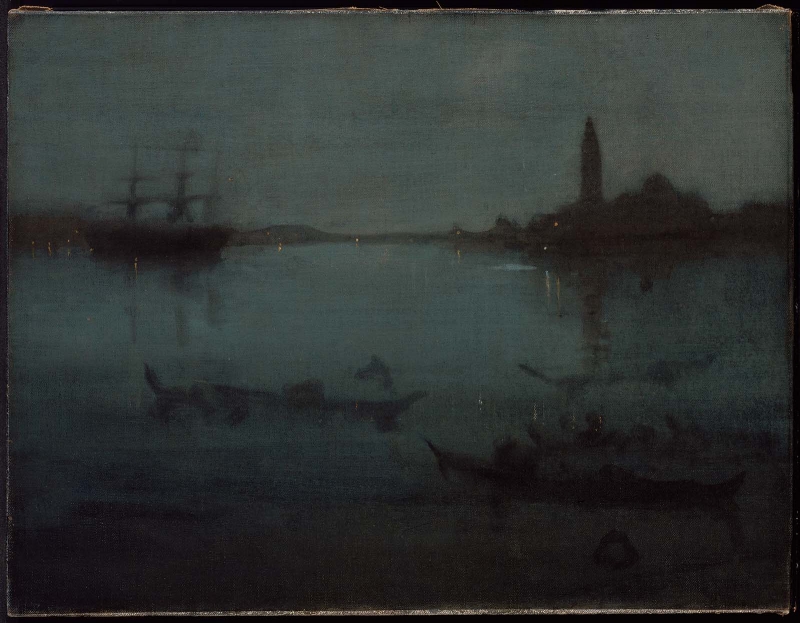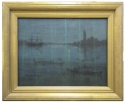Technique
The scene was painted with thin oil washes on a coarse weave canvas, in size roughly equivalent to the French 'toile de 15' (50 x 65 cm).
The conservator Sandra Kelberlau examined the canvas at the Museum of Fine Arts, Boston, in 2007, and her findings are summarised as follows:
'It is possible that the painting does not have a ground at all. The reddish brown color seen on the tacking margins is not a ground layer. … The other side of the canvas has a ground and the beginning of a painting. It is possible that the artist flipped the canvas over, coated the unprimed side with a dilute mixture of paint in oil, then proceeded to paint his composition. The picture is painted in such a way that exploits the texture of the canvas; the second layer of paint is thinner than the lower layer so that it sinks into the crevices of the canvas and exposes the lower paint level at the tops of the nubs of the canvas, creating a shimmering effect. The primed side of the canvas may have been too smooth to create this effect, necessitating use of the other side.' 1
The paint was smoothed and rubbed down by the artist to blur the shapes of figures, gondolas and ships, and the church, all 'emerging mysteriously from the enveloping misty blue darkness.' 2
Marc Simpson comments perceptively on Whistler's method and colour in this painting
'there is rich colour across its whole surface: no monochromatic flatness but an iridescence that results, painting conservators tell us, from thin veils of varying blue-grays (each comprising the three primary colors with admixtures of black and white) lying atop a roughened, absorbent canvas. Whistler's technical choices enrich the mute colours and exploit the texture of paint, "creating a shimmering effect." Through these unobtrusive means, rainbows of color lurk in the interstices of canvas warp and weft. This chromatic richness, just beyond the realm of casual sight, suggests depth and space, object and void, movement and stillness.' 3
Simpson adds 'The picture is … unlike most advanced painting of the era in two ways. First, so much darkness without focal points of illuminated interest is unusual … Second, and even more striking, there is no claim of virtuosic handling of brush or palette knife, no homage to paint's materiality. The wonder of the scene – its dark muteness – is augmented by the mystery, not the overt mastery, of its making.' 4
Conservation History
Unknown.
Frame
1903: the style and whereabouts of the original frame are unknown.
ca 1904: Whistler-style slope frame, American made, dating from ca 1904.
Notes:
1: Email from Sandra Kelberlau, Cunningham Assistant Conservator of Paintings, Museum of Fine Arts, Boston, to Marc Simpson, via Erica Hirschler, Croll Senior Curator of Paintings, MFA, 16 November 2007, quoted by Simpson, Marc, 'Whistler, Modernism, and the Creative Afflatus', in Simpson, Marc, Like Breath on Glass: Whistler, Inness, and the Art of Painting Softly, Sterling and Francine Clark Art Institute, Williamstown, MA, 2008, pp. 24-51, at p. 45 note 2.
2: MacDonald 2001 [more] , p. 30.
3: Simpson, Marc, 'Whistler, Modernism, and the Creative Afflatus', in Simpson, Marc, Like Breath on Glass: Whistler, Inness, and the Art of Painting Softly, Sterling and Francine Clark Art Institute, Williamstown, MA, 2008, pp. 24-51, at pp. 27 and 45 note 2.
4: Simpson 2008 op. cit., pp. 24-51, at p. 27.
Last updated: 4th June 2021 by Margaret








